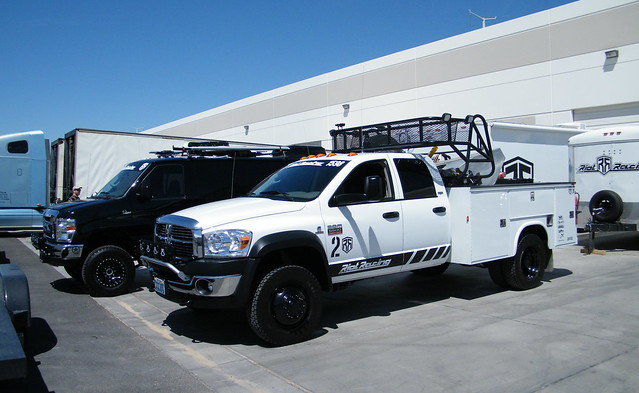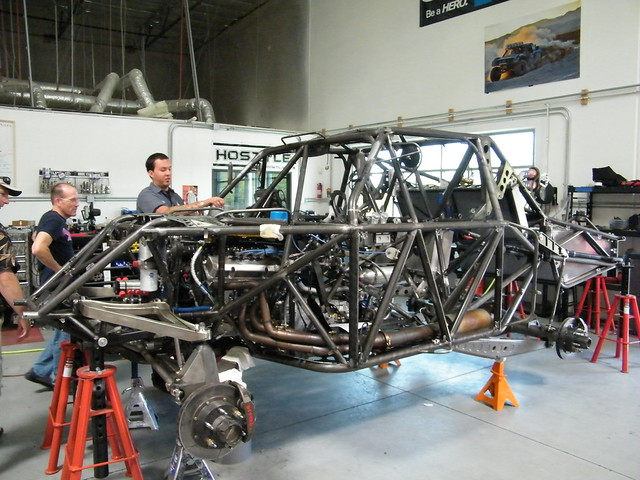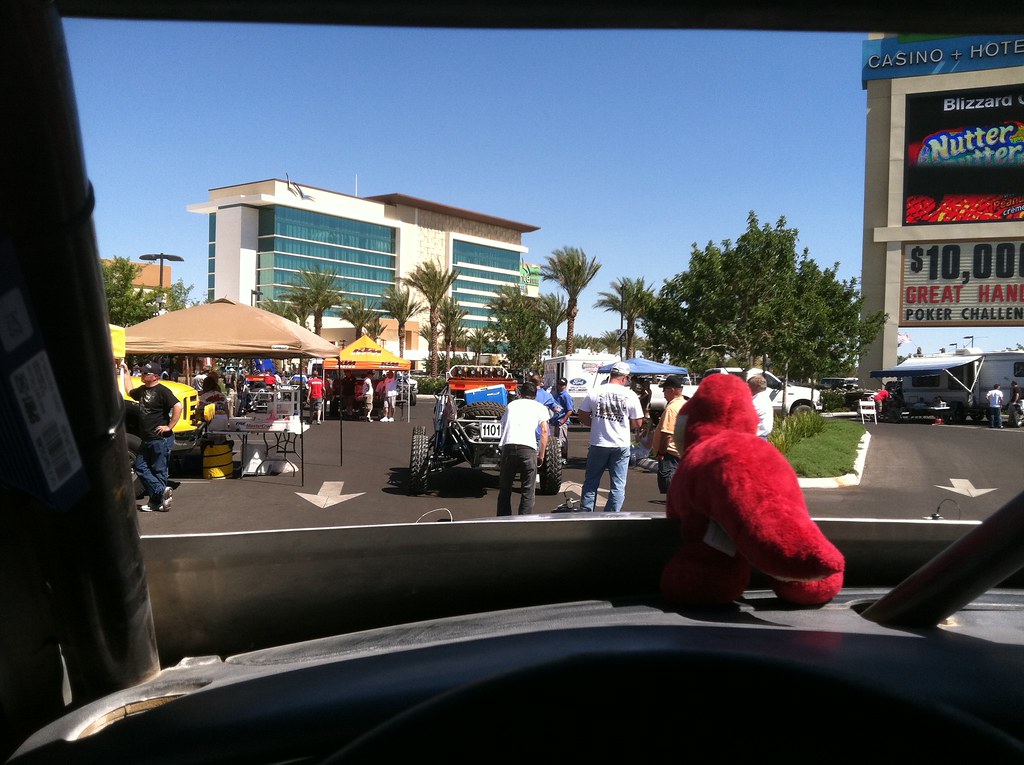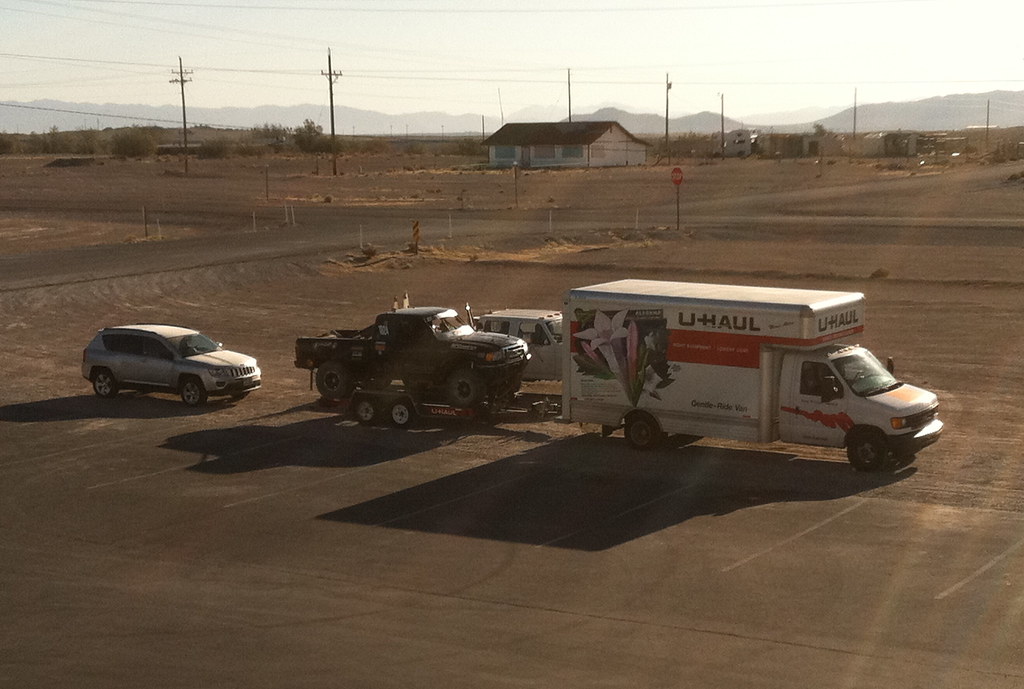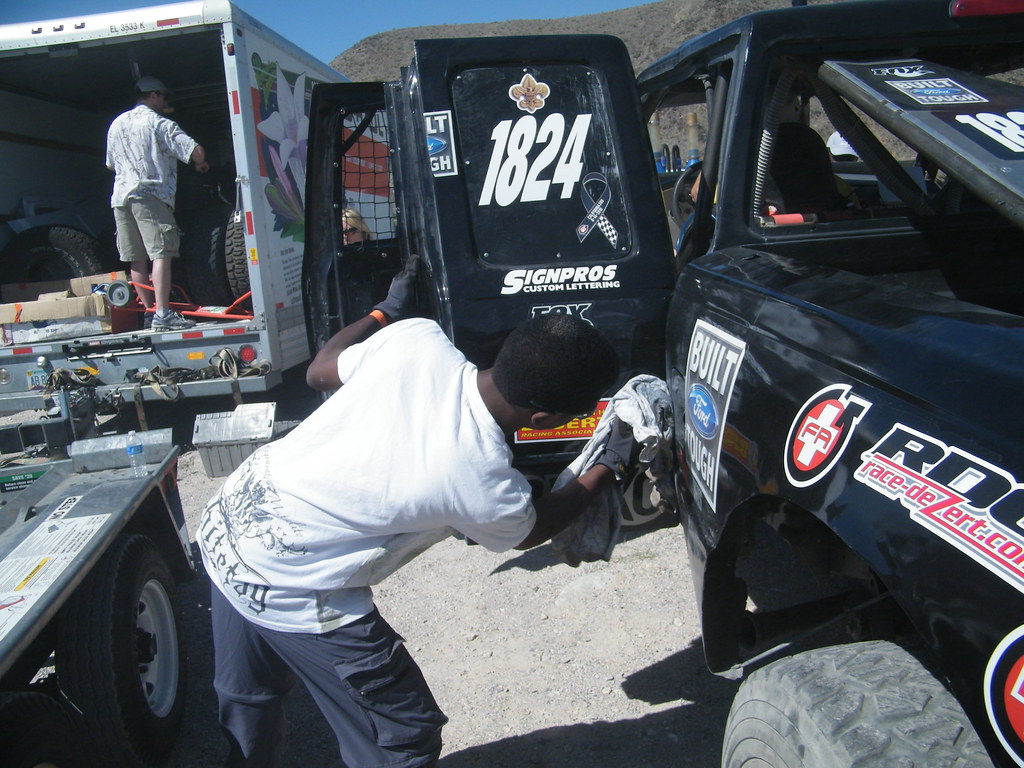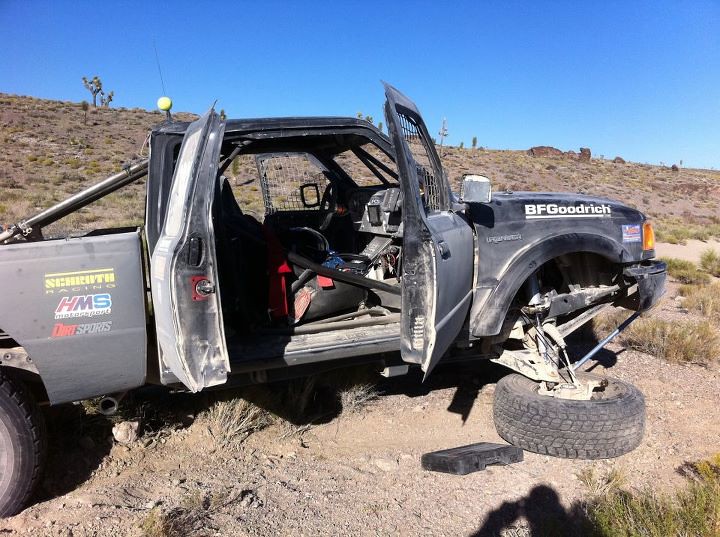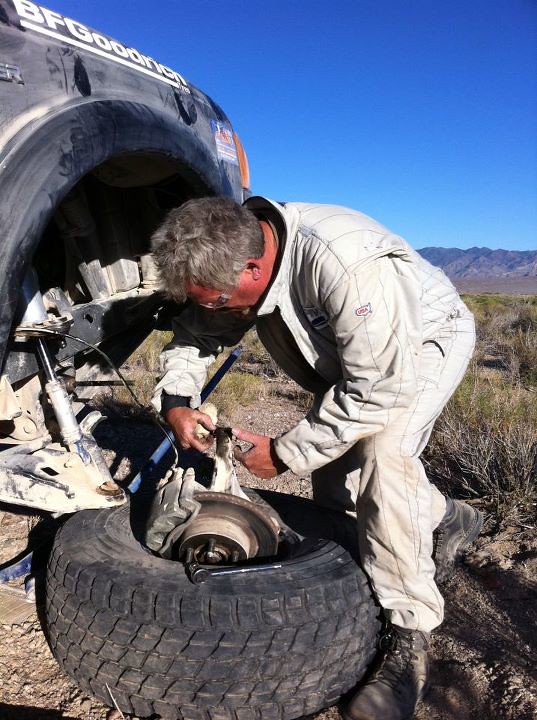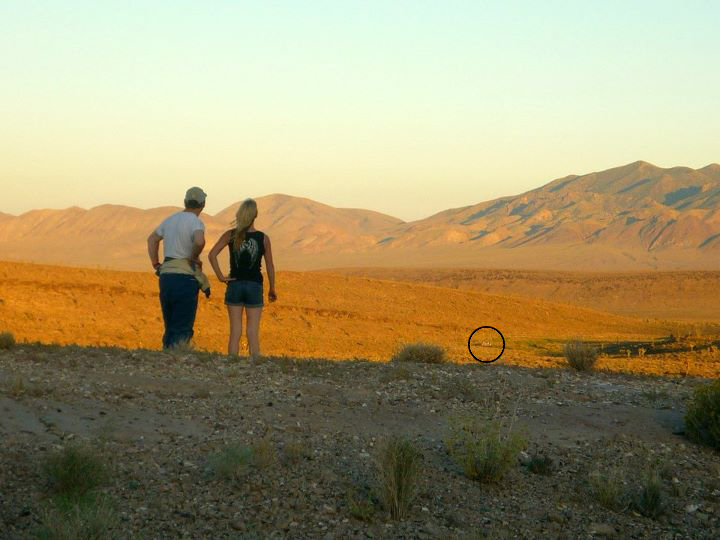The trip itself began on Tuesday the 16th. Most of our crew (a small group for this trip as many scouts couldn't get time off from their summer jobs) flew out of Logan, arriving in Vegas just after noon. We met up with Scott Nickerson, one of the co-drivers, who had arrived twelve hours earlier. The rental Jeep was procured, we checked into our first hotel (Texas Station), and prepared for the madness that was to come tomorrow, beginning with a shop tour at Riot Racing. Even though our internal clocks were still on New England time, sleep was hard to find that night. It still didn't feel real.
Wednesday began early, with an abbreviated breakfast followed by a trip to U-Haul to pick up the truck and trailer. Once we had the truck we headed back to the airport to get rally racer John Cassidy, one of the drivers, and made a beeline for Henderson and the Riot Racing shop. We arrived at what initially seemed like a nondescript industrial building, with nothing but the Riot logo on the glass door confirming we were at the right place. Driving around back, however, and the low-key image vanished. A collection of heavily equipped, HID-adorned chase trucks and trailers sat in front of a large overhead door, ready to go charging into the night after any race vehicle needing assistance. After circling each truck with longing gazes we stepped inside the shop, and into a different world. There were three race cars in the shop, two limited class buggies and the Riot trophy truck, all three stripped down to their frames, along with the Riot prerunner, which sat stealthily beneath a black car cover. On one wall was a shelving complex holding dozens of massive BF Goodrich tires, the top row well out of reach for anything short of a forklift, which conveniently sat nearby. Above the tires were the trophy truck's body panels, mounted on the wall like the art they most certainly were. Jordan Poole, co-driver of the Riot Racing trophy truck greeted us with a smile, leading us around the shop, answering our questions, and showing us the intricacies of each vehicle. After an hour or so of racers discussing racing we left, though not before Jordan had provided us with a healthy supply of Riot Racing stickers and posters.
Some of the chase trucks behind Riot Racing HQ
Jordan Poole showing John and Scott the trophy truck
From Riot we headed to Aliante Station, a hotel on the northern edge of Las Vegas. Aliante Station was the Las Vegas base for the race, and on this day was the registration point for time trials. Time trials were for the unlimited class vehicles, trophy trucks and class 1 buggies only, but spectating is often allowed along certain parts of the qualifying course, so we went to time trial registration and picked up the directions to the course. Qualifying, as it turned out, was being held in the desert about 15 miles northeast of the city, so we piled back in the cars and headed for the desert. We arrived as cars were running their practice lap (each car got one practice/recce lap), some drivers choosing the flat out approach to get a feel for the speed of the course, others opting to take it easy and find all the hidden gotchas. We parked amidst the steadily growing crowd of fans and watched the trucks race by, getting coated in dust as each screamed past.
The Canidae trophy truck on its practice lap
As we enjoyed the show our fourth and final driver, Doug Nagy, arrived, having driven from his home in California. With the team almost complete (our last member scheduled to arrive late that evening), we headed to Alamo, Nevada to finally see our steed for this race.
We arrived in Alamo around sunset, pulling into the driveway with the sun still peeking defiantly over the mountaintops. Outside the garage sat our chariot, the menacing black monster that would take us into battle on the desolate battlefield that was the Mojave desert. After a few minutes of talking about the truck, its controls, and its parts Steven went off with one of the truck's previous drivers to learn how to properly drive it. The rest of the team meanwhile started loading the U-Haul with the boxes of spares that came with the truck. After fifteen minutes the race truck rolled back into the driveway and Steven climbed out, the edges of a massive grin visible beneath his helmet. One by one each of our four drivers got a turn out in the desert with the new truck, feeling out its (and the drivers') abilities and limits. John and Doug, who were the most experienced racers and also scheduled to be in the truck together on race day, spent the most time testing, exploring the Alamo desert for about an hour before returning. In this time Steven discussed race strategy with the truck's former owner. He voiced the intention to do the driver change at the halfway point and was met with the question "Are you insane?" The man told us that they always tried to do driver changes every hundred miles or so, never exceeding 150 mile shifts. Anything longer than that tended to excessively wear a racer down. And with that our months of planning went partially out the window.
The new race truck
John and Doug returned and we loaded up the truck and the last of the gear and headed back for Vegas, this new revelation weighing on our minds. Once back at the hotel we took out the mileage chart and our pit strategy and began rearranging. The original plan was for Steve to drive the start to mile 289 with Scott as co-driver, then hand it off to Doug with John co-driving until mile 416, at which point John would take over driving duties from Doug and the two would take it to the finish. With a little quick recalculating we added two driver changes without affecting anyone's race mileage much. Steve and Scott would start, as planned, but would either stop at mile 159 or 99 if the triple digit heat proved to be too much. From 159 Doug would take over with John and take it to mile 289, where Steve and Scott would get back in, bringing it to mile 416 for John to take it home to the finish at mile 552. It meant an extra stop, but it would keep the drivers fresher. With that settled we went to bed. Registration and inspection were the following day.
We woke up around 9 and, after breakfast, went over the truck and the day's plan. We were going to check out of the Texas Station and, after inspection and the drivers' meeting, check into Longstreet Inn, a lone hotel located in the middle of nowhere on the California border, but within 45 miles of the start line (Las Vegas was about 2 hours from the start). The truck needed a few safety supplies, namely an emergency triangle, tool kit, and first aid kit, but was otherwise ready to go. We split up, with John and Doug going after the gear and the rest of us going straight to Aliante Station for inspection.
Desert inspection is a funny thing from a rally driver standpoint. In rally you typically line up at some nondescript garage and roll patiently roll through one at a time, get inspected, and go on your way. The line is always short because there's only 40 or so competitors. Thanks to the 300 vehicles at a desert race, the inspection line is a snaking parade of color and noise. Vendor trailers line the route, selling everything from DVDs to fan apparel to firesuits and radios for your race car. We didn't have any numbers for our truck yet, so our first stop along the route was the SignPros trailer (first trailer in the line) to get some new vinyl. As we were waiting for our numbers (and it was an impressively short wait) we discussed the project and the scouts and the SignPros crew decided to give us the vinyl for free. It was an incredible gesture. From there we rolled through the line, trying not to melt into the asphalt on the 110° day. We visited a few more trailers, making sure to stop for some Fast-Aid stickers for the truck. After about an hour we finally made it to the front of the queue. Our truck was poked, our firesuits were groped, and after about ten minutes our truck and safety gear was given a pass. We loaded the truck back on the trailer and quickly went inside for some drinks and air conditioning.
Desert inspection is a funny thing from a rally driver standpoint. In rally you typically line up at some nondescript garage and roll patiently roll through one at a time, get inspected, and go on your way. The line is always short because there's only 40 or so competitors. Thanks to the 300 vehicles at a desert race, the inspection line is a snaking parade of color and noise. Vendor trailers line the route, selling everything from DVDs to fan apparel to firesuits and radios for your race car. We didn't have any numbers for our truck yet, so our first stop along the route was the SignPros trailer (first trailer in the line) to get some new vinyl. As we were waiting for our numbers (and it was an impressively short wait) we discussed the project and the scouts and the SignPros crew decided to give us the vinyl for free. It was an incredible gesture. From there we rolled through the line, trying not to melt into the asphalt on the 110° day. We visited a few more trailers, making sure to stop for some Fast-Aid stickers for the truck. After about an hour we finally made it to the front of the queue. Our truck was poked, our firesuits were groped, and after about ten minutes our truck and safety gear was given a pass. We loaded the truck back on the trailer and quickly went inside for some drinks and air conditioning.
Some of the course markers set up at registration
The day was winding down astonishingly quick and we still had the driver meeting at 6, followed by the 100 minute drive out to the hotel. After some strategizing we decided to send Ron ahead to the hotel to check us into the rooms (the desk closed at 9). The rest of us had dinner then went to the drivers meeting.
The size of the meeting was amazing. Between drivers, co-drivers, and a few crew members who decided to listen in there were about a thousand people in attendance. Casey, the head of Best In The Desert, talked about race procedure, the course, and what to expect over the next two days. As he talked we found ourselves excitedly fidgeting in our seats. Race day was almost here. The meeting ended and, after filling our coolers with food and drinks and our gas tanks with fuel, we hit the road to Longstreet.
Arriving at the hotel around 11:00 we immediately got to work on the truck. The GPS wasn't installed yet and with three desert novices on the team this was something we certainly wanted to have. We fought the unfamiliar wiring system for over an hour, but made little progress. Exhausted we decided to give it up for the night, get some sleep, and see if we couldn't fix it in the morning.
7 am, race day. We got up, excited but uncertain. We were beginning to realize the size of our undertaking. With surprisingly little discussion we loaded up our gear and, after another couple hours of battling the GPS and having the same amount of luck, headed for the start.
The view from the front of the hotel
We arrived at the start around 10:40. Steve and Scott suited up, you could tell they were fighting off some jitters. Steve wedged Bacon in the truck's roll cage, the dinosaur had already voiced his intent to iron man the race. John and Doug did a final systems check, making sure all the electronics were working and everything looked good under the hood. Steve and Scott climbed in, did their belts, and headed for the start. Less than ten minutes later (sooner than we expected) we could hear the V6 whine as the truck went off the start. We were racing. We packed the gear and headed for pit 1, located at race mile 33.
Ellias gives the truck a quick cleaning before the start
We got to the first pit and set up. This was just going to be a quick preliminary stop to make sure Steve and Scott were good in the truck and everything was working properly. About an hour after we arrived (which felt like a day), the radio crackled. "1824 race, mile 30. Everything's good, we're coming in." Listening, we could hear the buzz of the engine. Soon the truck came into view, dropping off the crest across from us and rolling down the hill toward the pit entrance. Steve and Scott pulled in grinning and repeatedly using the word "awesome." They were in love with the ride already. Wanting to be thorough, Doug and John pulled the hood, which turned out to be a very good thing. A plug had come loose and was rubbing on the belt, wearing through it. The duo expertly did a belt swap and 15 minutes later the the truck was back on course. Load everything back up and on to pit 3 at mile 99.
Just to be safe we headed to pit 2 first, at mile 58, but as we were arriving we heard "1824 race, mile 65. They'd hauled butt and beat us to the pit. We turned it around and headed for 3. Pit 3 was a fun location because you could see the cars, at first only dust plumes like ground borne comets, descend out of the mountains (part of the Gold Peak mountain range), and run an arrow straight six mile stretch to the pits. Through the open plain we could hear the cars long before we could tell any kind of shape, or even tell there was a car at the head of that plume. As car after car went by we waited to hear from them on the radio.
A car on the road to pit 3
Suddenly Ron sat up slightly, pointing to a plume and saying "that one sounds like them." As if on cue the radio came to life. "1824 race, mile 95." We got the fuel cans out, this would be the first fuel stop. The truck hit pit entrance and slowed to the pit speed limit (or Steve's best guess thereof), crawling to where we stood waiting. They pulled in and shut off the truck. Taking off their helmets they jabbered excitedly about the mountains they had just driven over. As they went off to visit the port-a-john, we went to work refueling the truck and checking to make sure everything was intact. Upon removing the hood we once again found a minor problem, this time a cracked coolant hose. Like the belt we swapped it out and once again sent the truck out after a 15 minute pit stop.
The next stop was to be at pit 4, but we knew it would be a good two hours before the truck made it to the pit, since it was at mile 159. Fortunately the pit was on the outskirts of Goldfield, an old former mining town and the first sign of civilization we'd seen since the start at Beatty. We stopped in Goldfield for lunch and found a town frozen in time. The town hall and court house sat on the north side, with a large stone marker telling the history of Goldfield and how it became a boomtown shortly after the turn of the 20th century. Across the street was the fire house, built around the time of said population boom. Some of the original fire apparatus stood out front. A few blocks away was a house made entirely of stucco and beer bottles, built due to desperate need for materials, now a tourist stop. We made a lap up and down the street, taking it all in, then going to the Dusty Fender for food (the only restaurant in town). The place was small but the food was good and we enjoyed the relaxation.
Filled up, we went to the pit, located just northeast of town and right next to the boomtown-era graveyard. Doug and John got their safety gear on and prepared for their turn in the truck. "1824 race, mile 155." They were coming in. We suffered through the seemingly eternal final wait, wondering each time if the dust cloud over the rise is them, until finally the truck popped over the crest and into view. Steve and Scott pulled into the pit and got out of the truck, their minds still at race speed. The exhilaration they were feeling was overflowing and contagious. We found ourselves smiling and at ease as we did the driver change. Nothing wrong under the hood this time, so we were able to send the truck out in less than ten minutes, even with the driver change. Despite having just spent more than 5 hours in a black truck in triple digit heat wearing helmets and firesuits while traversing violently rough terrain, the duo looked fresher than the rest of us, the reason for which was shortly made clear when Scott declared the Parker Pumper to be the greatest racing invention ever. With the next pit just up the road for us, but 32 miles away for Doug and John, we sat for over a half hour as Steve and Scott regaled us with stories, trying to wind themselves down.
Eventually we got on the road and headed to pit 5 at race mile 191. Due to a low overpass between pits 4 and 5 (in a wash under the state highway) this was the earliest pit at which we could attach the light bar, so despite the new driver rotation this was still a mandatory pit location for us. We positioned the fuel cans and the light bar at the back of the truck, ready to go as soon as the race truck arrived. An hour went by and there was no sign of them. We were beginning to worry. Then we heard BFG Relay on our frequency, trying to call the race truck. We responded, identifying ourselves as 1824 chase. They informed us they'd gotten a call from the truck saying they were stopped at mile 172 with a broken tie rod and broken upper and lower ball joints on the passenger side wheel. This was not what we wanted to hear. We pulled out the maps and looked up the location. They were just after the low overpass. Doug's truck was the one with the radio, so we put a set of spare upper and lower control arms in the bed and headed for the overpass.
Arriving at the overpass we stared out into the desert and could just barely make out the unnatural shape of the truck, stranded in the desert. Now we had to find a way to get the arms to the truck. Only race vehicles and official vehicles are allowed to go out in the desert, and only driver/co-driver are allowed to work on the truck outside the pits, so we needed another race car or an official. Having no luck reaching Best in the Desert on the radio, we headed down the road. There was supposedly an alternate route with a BITD flagman for vehicles that were too tall for the 7 foot overpass, so if we could find it, maybe we could get help from the flagman. We saw a dirt road opening that looked promising and turned into it. Unfortunately it proved to be nothing but the driveway for a construction company. At that very moment, however, a Best in the Desert official truck drove by. Recognizing us as a chase truck, he stopped and turned around to see if we needed assistance. We explained the situation and he agreed to take the arms out to the race truck. Elated we tossed them in the back of his truck and watched as he drove out to deliver them. Maybe we weren't done after all.
The broken truck, photo courtesy of John
Doug working to repair the truck
The arms went out and we waited as patiently as we could to hear word back. After a half hour or so it came. "The lower control arm is for the wrong side." Crap. Fortunately we had brought both lowers, just in case. Unfortunately there was no sign of a race vehicle or official to help us this time. Not ready to give up, Scott scavenged a ratchet strap from the bed of the chase truck, strapped the control arm (which weighs at least 20 lbs) to his back, and ran (or did his best attempt at running) the mile through the silt to deliver the arm. In that heat I thought he was either mad or secretly Superman. Turns out he's both. With the arm delivered it was now a waiting game.
Scott and Riley stare helplessly out at the race truck (circled)
Time dragged by and the sun began dropping. As it began dropping behind the mountains John came back on the radio. Between complications with the repairs and the fact that the truck didn't have the light bar there was no way they'd be able to make it to pit 5 before closing time. This was the end. The new plan was for Doug and John to fix the truck, drive it back to the road, and load it up on the trailer. The effect of the news was instant and intense. Suddenly we all felt tired, worn down. There was nothing we wanted more than to just pack it in and go. Hours crawled by. The jack Doug and John had stopped working, so we had to throw a spare into the bed of another race truck, one desperately chasing the pit closing time. We waited what felt like an eternity then, finally, headlights in the desert heading our way. With only some of the right tools and sheer determination Doug and John had fixed the truck.
We loaded up and drove back to Goldfield to organize ourselves, standing in a deserted parking lot under a lone street light with the hour approaching midnight. For Doug continuing to Reno meant going further from home than he needed to, so he decided to head back toward California. With most of us having booked flights out of Reno, the rest of us needed to continue north toward the finish. Steve, who was probably feeling more frustrated and dejected than the rest of us, wanted to push and do the full 5 hour drive to our scheduled Reno hotel. The rest of us, knowing we were too tired to make it, talked him into getting rooms at the nearest hotel. Steven agreed, but told us he doubted Tonopah (only a half hour away) probably wouldn't have any vacancies and we'd have to go to Hawthorne (over 2 hours away) to find a room. We reached Tonopah and sure enough every room was booked, including the Clown Motel (good news for Steve as his phobia was starting to show). After checking every hotel and motel we filled the gas tanks and began the push for Hawthorne.
Ironically, it was Steve who surrendered first. He called back saying he was beginning to get the "long blink," dangerous under any circumstance, terrifying with nearly 50 feet of box truck and trailer. We found a dirt lot at an intersection and bedded down for the night, Steven opting to sleep on the shelf in the back of the U-Haul. We rested for about four hours, then got back on the road to Hawthorne, found a room at El Capitan, and went back to sleep. Yep, we were tired.
We finally woke up around noon. First thing we did was take turns showering, getting 24 hours of desert off of us. Steve and Scott probably clogged the drain. Refreshed, clean, and having had time to absorb the previous day, we headed for Reno feeling much better. That night after the award ceremony we sat in the hotel restaurant, trading stories of this race, other races, and various other experiences and adventures. Even John, who signed on less than a month in advance with the intent to drive but ended up co-driving 12 miles then wound up stuck in the desert for 5 hours fixing the truck got into telling stories of the day, explaining how he and Doug had donned warrior headbands while doing repairs. Every one of us agreed, despite it all and in fact because of it all we'd had a great time. It was there in the restaurant as we reflected upon the week that we realized while we may not have finished the race and it may have been a success from a competitive standpoint, we had an adventure most can only dream of and stories we'll be telling all our lives. And that was the greatest victory of all.
Some of the crew, in Reno at last
See Steve and Ron's (and the event photographer's) photos here: Flickr Photo Gallery
See the team photos here: Facebook Photo Gallery
